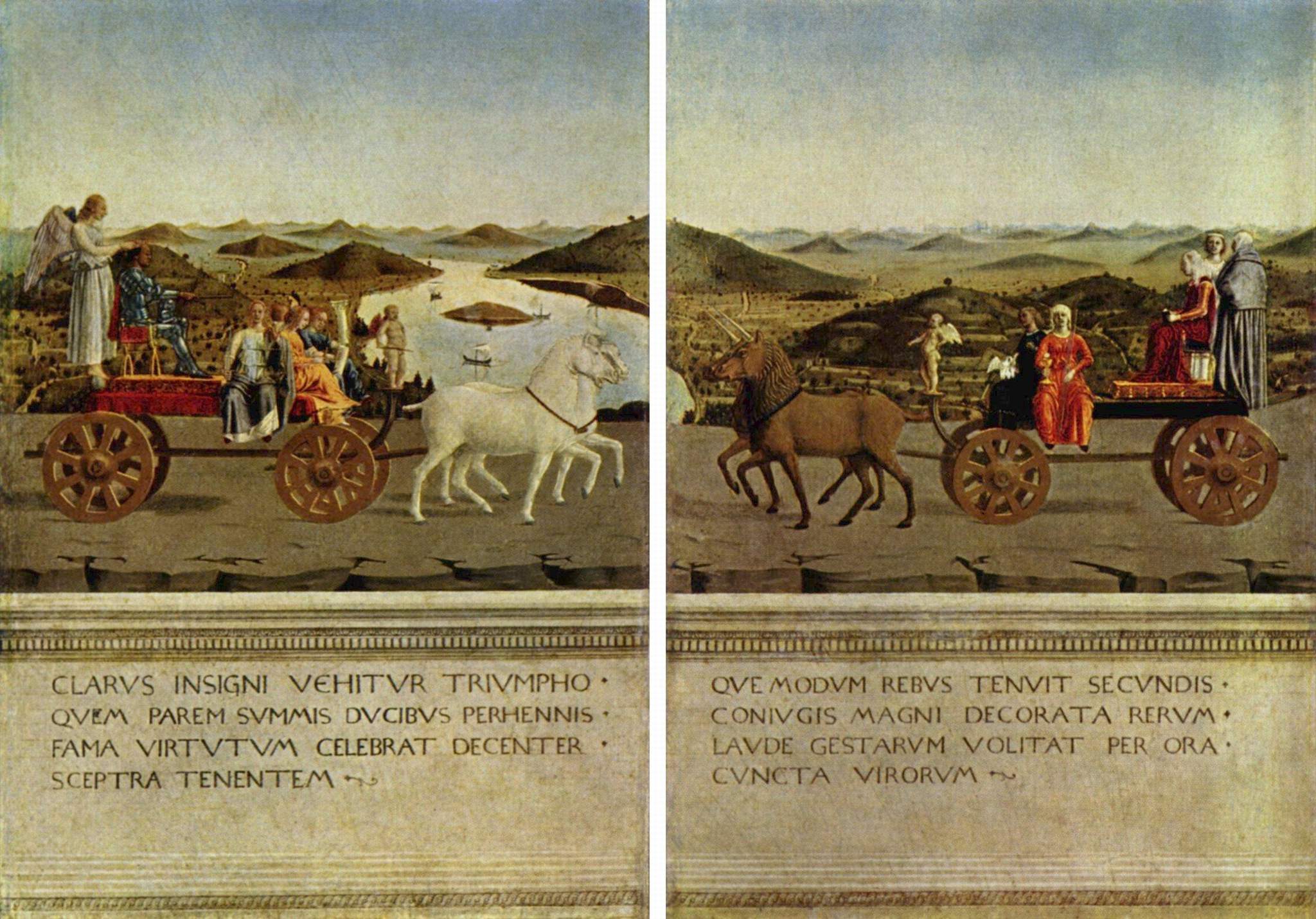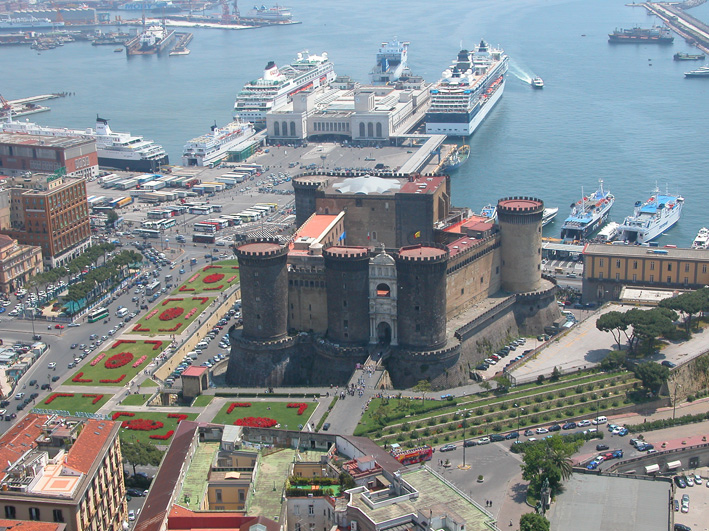|
Trionfo
Trionfo () is an Italian word meaning "triumph", also "triumphal procession", and a triumphal car or float in such a procession. The classical triumphal procession for victorious generals and Emperors known as the Roman Triumph was revived for "Entries" by rulers and similar occasions from the Early Renaissance in 14th and 15th-century Italy, and was a major type of festival, celebrated with great extravagance. The cars are shown as open-roofed, many clearly utilitarian four-wheeled carts dressed-up for the occasion. Others were two-wheeled chariots. In art, they might be pulled by all sorts of exotic animals. Another specialized sense of the word was an elaborate sugar sculpture; these decorated tables on important occasions in the Renaissance and Baroque periods, especially in Italy and France. Eventually they were replaced by the silver surtout de table or porcelain centrepieces. The word may derive from a call of triumph during antique triumphal processions: "Io triump ... [...More Info...] [...Related Items...] OR: [Wikipedia] [Google] [Baidu] |
Olympic Medal
An Olympic medal is awarded to successful competitors at one of the Olympic Games. There are three classes of medal to be won: gold, silver, and bronze, awarded to first, second, and third place, respectively. The granting of awards is laid out in detail in the Olympic protocols. Medal designs have varied considerably since the Games in 1896, particularly in the size of the medals for the Summer Olympic Games. The design selected for the 1928 Games remained for many years, until its replacement at the 2004 Games in Athens as the result of controversy surrounding the use of the Roman Colosseum rather than a building representing Greek roots. The medals of the Winter Olympic Games never had a common design, but regularly feature snowflakes and the event where the medal has been won. In addition to generally supporting their Olympic athletes, some countries provide sums of money and gifts to medal winners, depending on the classes and number of medals won. Introduction and ea ... [...More Info...] [...Related Items...] OR: [Wikipedia] [Google] [Baidu] |
Triumphs
''Triumphs'' (Italian language, Italian: ''I Trionfi'') is a 14th-century Italian series of poems, written by Petrarch in the Tuscan language. The poem evokes the Roman triumph, Roman ceremony of triumph, where victorious generals and their armies were led in procession by the captives and spoils they had taken in war. This was a popular and influential poem series when it was published. Composed over more than twenty years, the poetry is written in ''terza rima''. It consists of twelve chapters ordered in six triumphs envisioned by the poet in a dream honoring Allegory in the Middle Ages, allegorical figures such as Eros, Love, Pudicitia, Chastity, Death (personification), Death, and Pheme, Fame, who vanquish each other in turn. Further triumphs are awarded to Time and Eternity. Composition of the work started in 1351 and the final chapter was last edited on February 12, 1374, a few months before the author's death. The book was produced in many lavish illuminated manuscript versio ... [...More Info...] [...Related Items...] OR: [Wikipedia] [Google] [Baidu] |
Roman Triumph
The Roman triumph (') was a civil religion, civil ceremony and Religion in ancient Rome, religious rite of ancient Rome, held to publicly celebrate and sanctify the success of a military commander who had led Roman forces to victory in the service of the state or in some historical traditions, one who had successfully completed a foreign war. On the day of his triumph, the general wore a crown of laurel and an all-purple, gold-embroidered triumphal ''toga picta'' ("painted" toga), regalia that identified him as near-divine or near-kingly. In some accounts, his face was painted red, perhaps in imitation of Rome's highest and most powerful god, Jupiter (mythology), Jupiter. The general rode in a four-horse chariot through the streets of Rome in unarmed procession with his army, captives, and the spoils of his war. At Temple of Jupiter Optimus Maximus, Jupiter's temple on the Capitoline Hill, he offered sacrifice and the tokens of his victory to the god Jupiter. In Roman Republic, ... [...More Info...] [...Related Items...] OR: [Wikipedia] [Google] [Baidu] |
Giuseppe Cassioli
Giuseppe Cassioli (22 October 1865 – 5 October 1942) , Olympic Games Museum. Accessed 27 July 2011. was an Italian painter and sculptor known for his medal design. Many of his paintings are on display at the Museo Cassioli di Pittura senese dell'Ottocento in , Tuscany. Biography Cassioli was born in , |
Maximilian I, Holy Roman Emperor
Maximilian I (22 March 1459 – 12 January 1519) was King of the Romans from 1486 and Holy Roman Emperor from 1508 until his death. He was never crowned by the pope, as the journey to Rome was blocked by the Venetians. He proclaimed himself Elected Emperor in 1508 (Pope Julius II later recognized this) at Trent, thus breaking the long tradition of requiring a Papal coronation for the adoption of the Imperial title. Maximilian was the son of Frederick III, Holy Roman Emperor, and Eleanor of Portugal. Since his coronation as King of the Romans in 1486, he ran a double government, or ''Doppelregierung'' (with a separate court), with his father until Frederick's death in 1493. Maximilian expanded the influence of the House of Habsburg through war and his marriage in 1477 to Mary of Burgundy, the ruler of the Burgundian State, heir of Charles the Bold, though he also lost his family's original lands in today's Switzerland to the Swiss Confederacy. Through marriage of his son Phil ... [...More Info...] [...Related Items...] OR: [Wikipedia] [Google] [Baidu] |
Jean Fouquet
Jean (or Jehan) Fouquet (ca.1420–1481) was a French painter and miniaturist. A master of panel painting and manuscript illumination, and the apparent inventor of the portrait miniature, he is considered one of the most important painters from the period between the late Gothic and early Renaissance. He was the first French artist to travel to Italy and experience first-hand the early Italian Renaissance. Little is known of Fouquet's early life and education. Though long assumed to have been an apprentice of the so-called Bedford Master of Paris it is now suggested that he may have studied under the Jouvenal Master in Nantes, whose works were formerly assumed to be early works by Fouquet. Sometime between 1445 and 1447 he travelled to Italy where he came under the influence of Roman Quattrocento artists such as Fra Angelico and Filarete. During the 1450s he began working at the French court, where he counted kings Charles VII and his successor Louis XI among his many patrons. ... [...More Info...] [...Related Items...] OR: [Wikipedia] [Google] [Baidu] |
Jehoshaphat
Jehoshaphat (; alternatively spelled Jehosaphat, Josaphat, or Yehoshafat; ; el, Ἰωσαφάτ, Iosafát; la, Josaphat), according to 1 Kings 22:41, was the son of Asa, and the fourth king of the Kingdom of Judah, in succession to his father. His children included Jehoram, who succeeded him as king. His mother was Azubah. Historically, his name has sometimes been connected with the Valley of Josaphat. Reign 2 Chronicles chapters 17 to 21 are devoted to the reign of Jehoshaphat. 1 Kings 15:24 mentions him as successor to Asa, and 1 Kings 22:1-50 summarizes the events of his life. The Jerusalem Bible states that "the Chronicler sees Asa as a type of the peaceful, Jehoshaphat of the strong king". According to these passages, Jehoshaphat ascended the throne at the age of thirty-five and reigned for twenty-five years. He "walked in the ways" of his father or ancestor, King David. He spent the first years of his reign fortifying his kingdom against the Kingdom of Israel. His ... [...More Info...] [...Related Items...] OR: [Wikipedia] [Google] [Baidu] |
Piero Della Francesca
Piero della Francesca (, also , ; – 12 October 1492), originally named Piero di Benedetto, was an Italian painter of the Early Renaissance. To contemporaries he was also known as a mathematician and geometer. Nowadays Piero della Francesca is chiefly appreciated for his art. His painting is characterized by its serene humanism, its use of geometric forms and perspective. His most famous work is the cycle of frescoes ''The History of the True Cross'' in the church of San Francesco in the Tuscan town of Arezzo. Biography Early years Piero was born Piero di Benedetto in the town of Borgo Santo Sepolcro, modern-day Tuscany, to Benedetto de' Franceschi, a tradesman, and Romana di Perino da Monterchi, members of the Florentine and Tuscan Franceschi noble family. His father died before his birth, and he was called Piero della Francesca after his mother, who was referred to as "la Francesca" due to her marriage into the Franceschi family (similar to how Lisa Gherardini became kno ... [...More Info...] [...Related Items...] OR: [Wikipedia] [Google] [Baidu] |
The Duke And Duchess Of Urbino
The Diptych of Federico da Montefeltro and Battista Sforza are two oil paintings by Italian artist Piero della Francesca, dated to 1473–1475. This famed double portrait is often mistitled ''The Duke and Duchess of Urbino''—as it appears on the website of the Uffizi Gallery, which owns it. Since Battista Sforza died in 1472 and Federico da Montefeltro was not made duke until 1474, however, Battista never attained the title of duchess. Genesis of the work The Uffizi describes the work as follows: One of the most celebrated portraits of the Italian Renaissance, the diptych features the Duke of Urbino Federico da Montefeltro (1422–1482) and his wife Battista Sforza (1446–1472). In the tradition of the fourteenth century, inspired by the design of ancient coins, the two figures are shown in profile, an angle that ensured a good likeness and a faithful representation of facial details without allowing their sentiments to show through: indeed, the Duke and Duchess 'sic''of Ur ... [...More Info...] [...Related Items...] OR: [Wikipedia] [Google] [Baidu] |
Alfonso V Of Aragon
Alfonso the Magnanimous (139627 June 1458) was King of Aragon and King of Sicily (as Alfonso V) and the ruler of the Crown of Aragon from 1416 and King of Naples (as Alfonso I) from 1442 until his death. He was involved with struggles to the throne of the Kingdom of Naples with Louis III of Anjou, Joanna II of Naples and their supporters, but ultimately failed and lost Naples in 1424. He recaptured it in 1442 and was crowned king of Naples. He had good relations with his vassal, Stjepan Kosača, and his ally, Skanderbeg, providing assistance in their struggles in the Balkans. He led diplomatic contacts with the Ethiopian Empire and was a prominent political figure of the early Renaissance, being a supporter of literature as well as commissioning several constructions for the Castel Nuovo. Early life Born at Medina del Campo, he was the son of Ferdinand of Trastámara and Eleanor of Alburquerque. Ferdinand was the brother of King Henry III of Castile, and Alfonso was betrot ... [...More Info...] [...Related Items...] OR: [Wikipedia] [Google] [Baidu] |
Castel Nuovo
Castel Nuovo (; "New Castle"), often called Maschio Angioino (; "Angevin Keep"), is a medieval castle located in front of Piazza Municipio and the city hall ( Palazzo San Giacomo) in central Naples, Campania, Italy. Its scenic location and imposing size makes the castle, first erected in 1279, one of the main architectural landmarks of the city. It was a royal seat for kings of Naples, Aragon and Spain until 1815. It is the headquarters of Neapolitan Society of Homeland History and of the Naples Committee of the Institute for the History of the Italian Risorgimento. In the complex there is also the civic museum, which includes the Palatine Chapel and the museum paths on the first and second floors. History The origins and the dynasty of the House of Anjou The construction of its former nucleus -today partly re-emerged following restoration and archaeological exploration work- is due to the initiative of Charles I of Anjou, who in 1266, defeated the Hohenstaufens, ascend ... [...More Info...] [...Related Items...] OR: [Wikipedia] [Google] [Baidu] |








